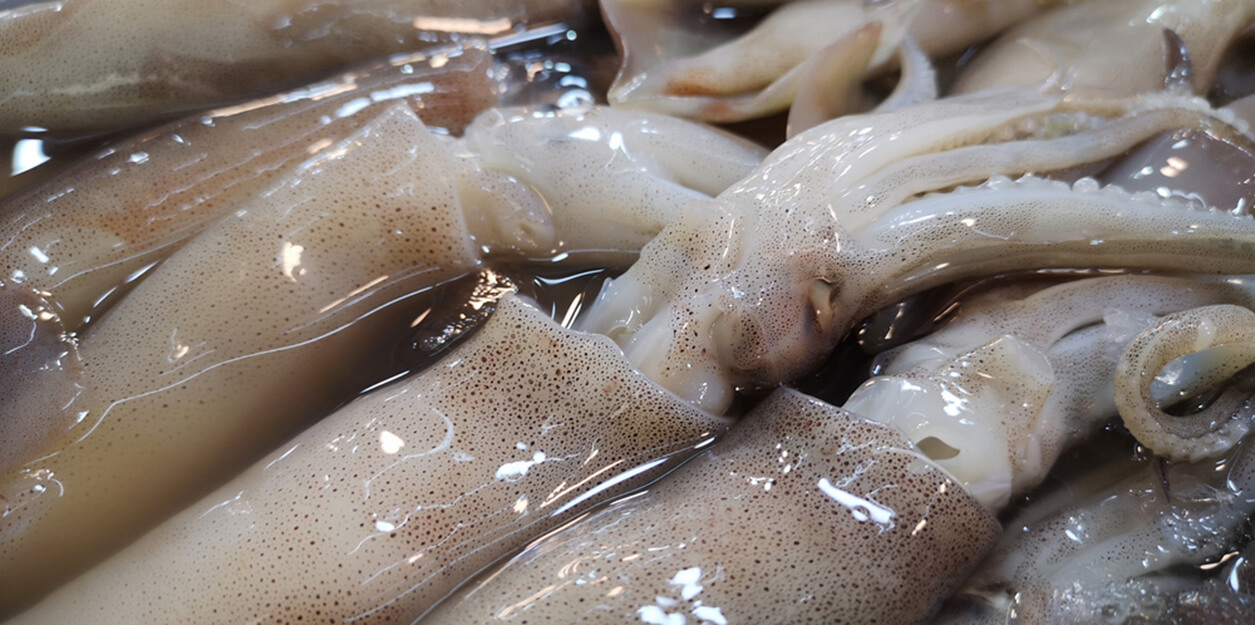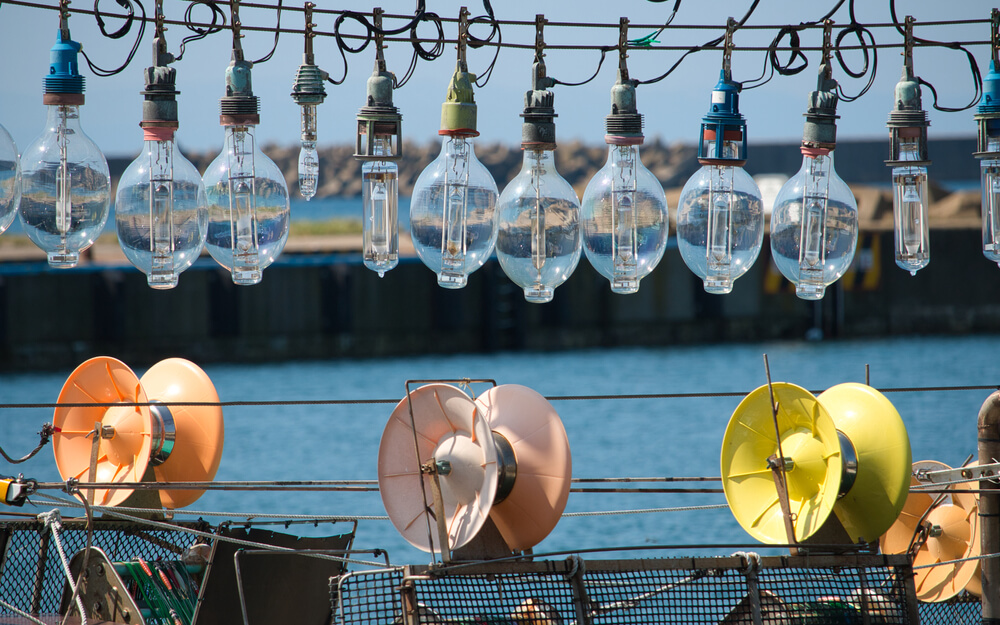Rise in Unregulated Fishing for Squid Hurts Species and People
Overview
In the world of ocean conservation, big problems often arise while people are looking elsewhere. Such is the case today with the global squid fishery, which consists of hundreds of vessels fishing for the species, largely in unregulated waters around the world. A significant portion of this fleet fishes exclusively at night, using an array of bright lights to lure squid toward the surface where they are snagged with barbed lures and hauled on board.
These lights are so intense that they are visible in images of Earth taken from space, particularly when vessels amass in fertile fishing grounds. But despite that luminescence and the high volume of fishing, many of these vessels are operating in the dark, so to speak, due to limited regulation of the international squid fishery.
Now new research sheds light on this activity—where it is occurring, which countries are doing the fishing, and how much they are catching—and concludes that this sector of the fishing industry needs much greater oversight.
New research reveals expanding footprint of global squid fishing fleet
In March 2023, Science Advances published a new study, “Fishing through the cracks: the unregulated nature of global squid fisheries,” which found that in 2020 squid fishing vessels around the world worked a combined 251,000 vessel days. These units of effort track the number of days vessels are active and equate to around 685 years’ worth of around-the-clock activity. Those numbers are up 68 percent from the 149,000 vessel days fished in 2017. The study was carried out under a research partnership between Global Fishing Watch, the University of California, Santa Cruz, the Australian National Centre for Ocean Resources and Security and the Japan Fisheries Research and Education Agency, and focused on four areas: the southwest Atlantic Ocean, northwest Indian Ocean, and the northwest and southeast Pacific Ocean.
To learn which vessels were fishing where and when, the authors combined data from vessels’ automatic identification system transponders and from a satellite technology called the visible infrared imaging radiometer suite, which shows those bright lights on the ocean at night. They then compared this activity to areas of competence for national and regional fisheries management bodies and squid regulations to determine how much fishing was happening in unregulated areas.
Largely unregulated fishery has strong potential for improved management
China’s distant-water fishing fleet makes up the bulk of light-luring vessels examined for this study—1,123 of the 1,394 vessels studied—and accounted for 4 million hours of fishing, or 92 percent of all the fishing tracked. This helps explain why China reported that in 2020 its vessels landed 520,300 metric tons of squid—the country’s number one catch for the year, ahead of tuna (with 327,400 metric tons landed). Other major squid fishing countries include the Republic of Korea, Chinese Taipei and Japan.
Unregulated fishing of any species poses numerous problems. The first one is somewhat obvious: the absence of controls on the quest for profit will invariably lead to over-exploitation of the target species. Second, unregulated spaces are often directly adjacent to regulated ones—for example, coastal States’ exclusive economic zones (EEZs)—which means fishers in relatively small artisanal boats end up competing with huge industrial vessels fishing just outside the EEZ boundaries.
0%
China’s distant-water fishing fleet makes up 92 percent of all the fishing tracked in the study.
Unregulated fishing therefore exacerbates inequity for traditional and small-scale fishers, as well as for developing coastal States that depend on revenue from commercial fishing. In many cases unregulated catch is not reported or incorporated into estimates of fishing effort, harvest, or stock status, making it difficult to ascertain whether the fishing is sustainable. Further, unregulated fishing is subject to considerably less scrutiny than regulated activities, and as such, is more likely to be associated with questionable labor practices, human rights violations and other crimes.
One of the reasons the authors undertook this work was to more closely examine the unexplored realm of unregulated fishing. Despite its substantial harm to fish populations, marine ecosystems, artisanal fishers and coastal communities, unregulated fishing has received little attention in recent years compared to that of illegal fishing. The study authors were careful to note that they were not implying that the vessels and crews fishing for squid in unregulated waters were doing anything illegal, and that it is the areas of ocean—not the vessels themselves—that are unregulated.
Among other important findings, the research quantified how highly mobile light-luring squid fishing vessels are—more than half of those studied operated in multiple regions many times a year. The fleets are also highly nomadic, with vessels moving globally between management areas based on licensed fishing seasons and seasonal abundances and migratory patterns of their target species.

The light-luring vessels also stay at sea on average for three months to one year at a time, far longer than the average fishing trip for other commercially fished species. They are able to do that because of support from refrigerated carrier vessels which rendezvous with the squid fishers in the open ocean to take on their catch and re-supply them with food and fuel.
This is important because it facilitates near-constant fishing and puts added pressure on the squid population, which experts believe is in decline, both globally and in each of the areas studied. Highlighting this concern, the study found that fishing pressure in the northwest Indian Ocean and southwest Pacific Ocean—areas with no management of squid fishing—increased from 2017 to 2020 while fishing pressure in the northwest Pacific Ocean, where there is at least some oversight of the activity, remained static during that time. In particular, in the northwest Indian Ocean, fishing effort increased rapidly from 13,000 to 56,000 vessel days from 2017 to 2020, and the number of vessels working there jumped more than fourfold, from 57 to 250.
Overall, although some conservation and management measures are in place around the world to regulate squid fishing, the study concluded that fleets may take advantage of fragmented regulations to maximize catch. And there certainly are suggestions that unregulated squid fishing is contributing to declines in the species’ numbers. For example, in 2020 the Chinese government placed restrictions on its own squid fleet—in certain places and for limited times—presumably out of concern that they were catching too many squid.
Also, in February 2023 the South Pacific Regional Fisheries Management Organization (SPRFMO) adopted a measure that will limit fishing effort, which caps how much vessels can fish for squid in the region it covers, the high seas of the South Pacific Ocean. Effort limits can manifest in a variety of ways—for example, the number of vessels in the fishery, the capacity of the vessels, catch limits, or other factors that affect fishing efficiency. The SPRFMO action, which was proposed by a small handful of member States, indicates that the organization recognizes the threat that unchecked fishing poses to the squid population.
The table is now set for governments, companies, and regulatory bodies to collectively take action to regulate squid fishing with intentional steps to increase communication and data sharing. Failure to do so could result in a confusing latticework of regulation that fishers may continue to exploit.

